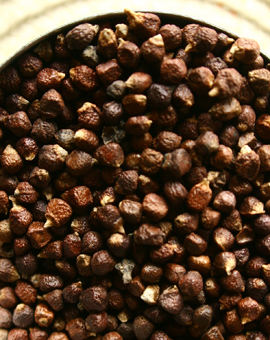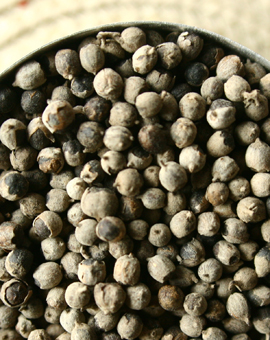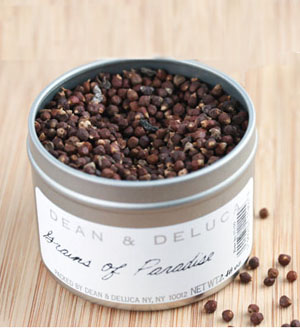MALAGUETA PEPPER or MALAGUETTA PEPPER
One needs to pay careful attention here: Malagueta pepper (spelled with an “a”), used in Brazilian cooking, is a member of the capsicum family (Capsicum frutescens, a member of the Solanaceae family). A small red chile, about two inches long at maturity, it is found in the Bahia area of Brazil, it is a hot chile scoring 9.5 on a scale of 10. It is similar to the birdseye chile in both appearance and flavor. The malagueta chile apparently got its name from the unrelated melegueta pepper (spelled with an “e”—see the next listing), a West African spice, because the Brazilian state of Bahia was a center of slave trade: The Portuguese name for the African spice was transferred to the local capsicum. Malagueta is served throughout Brazil, typically minced with oil in a salsa, as a very hot table condiment or to season dishes. It is totally unrelated to the melegueta pepper of Africa, which comes from a ginger-like rhizome. Learn more about chiles in our Chile Glossary.
MELEGUETA PEPPER (or Alligator Pepper or Grains Of Paradise or Guinea Grains or Meleguetta Pepper)
Aframomum melegueta, from the Zingiberaceae family (the ginger family), is also popularly known as grains of paradise. It was named by the Portuguese traders in the fifteenth century, who encountered it along the stretch of West African coast they called the Malagueta (now Liberia. The name, “grains of paradise,” was developed by some clever spice trader looking to command a price for something rare. He claimed that the seeds grew only in Eden, and were gathered as the “grains” floated down the river out “of paradise.” Even coming from paradise, the spice was less expensive than the very pricey true black pepper (Piper nigrum).
These “grains” are small, red-brown seeds of a cardamom-like plant (cardamom is also a rhizome, a horizontal, usually underground stem of a plant that often sends out roots and shoots from its nodes). They have an aromatic, spicy bouquet and a pungent, hot and peppery taste that is slightly fruity, tasting strongly of ginger and cardamom. Numerous seeds are contained in a wrinkled, brown, fig-shaped capsule about 1-1/4” in length. Grains of Paradise are rarely found in the West today, although they were used in Europe in the Middle Ages and Renaissance as a flavoring for wine, beer, spirits and vinegar. They were popular in Europe from the time of Elizabeth I (1533-1603), who was fond of them, until the time of George III (1738-1820), who prohibited them.*
|
|
 Grains of Paradise: Largely confined to West Africa, these tiny seeds are related to cardamom, and resemble the seeds inside cardamom pods. Photo by Brian Van Sise | THE NIBBLE. Grains of Paradise: Largely confined to West Africa, these tiny seeds are related to cardamom, and resemble the seeds inside cardamom pods. Photo by Brian Van Sise | THE NIBBLE.
|
The melegueta pepper was soon overshadowed by chiles from the Americas, and dwindled in importance in both Africa and Europe.
Use For: Grains of Paradise complement root vegetables, lamb and poultry, and combine well with allspice, cinnamon, cloves, cumin and nutmeg. They are generally confined to West African cookery, though sometimes may be found in Moroccan ras el hanout blends. The seeds are used in Scandinavia to flavor aquavit.
Melegueta pepper is not related to malagueta pepper, above. Given the similarity of the spelling, and the variations on the spelling of melegueta, most people—even authors of food books—have erroneously assumed it is the same spice. However, as with Christopher Columbus naming the hot chiles he found in the New World “peppers,” because his only frame of reference was the [totally unrelated] black peppercorn, the Portuguese traders who knew the hot melegueta seeds from Africa also named the hot Brazilian chile “malagueta.”
*Kenneth Kiple, The Moveable Feast: Ten Millennia Of Food Globalization, 2007: Cambridge University Press, p. 58.
|
MOULA (or Chasteberries or Monk’s Berries)
From Hungary, moula is the tart and slightly peppery fruit of the chaste tree (Vitex agnus-castus), a small warm-climate shrub native to western Asia and southwestern Europe that is now common in much of the southeastern United States. The tree is so-named because, dating back to the beginning of the common era, the fruit was believed to suppress the libido. The Greek physician and pharmacologist Pedanius Dioscorides (40 to 90 C.E.) recommended it in beverages to help the wives of soldiers remain chaste while their husbands were away and Pliny, the great Roman natural historian (23 to 79 C.E.) wrote that the plant “checks violent sexual desire.”
|
|

Moula, or Chasteberries, from Hungary. Photo by Brian Van Sise | THE NIBBLE.
|
That use has been discounted in modern clinical trials, but it is efficacious as a homeopathic PMS remedy.† The small, taupe-colored dried berries are very hard, with a musty earth taste reminiscent of old wine. They don’t give off the same level of heat as most of the other berries, but are attractive as a garnish.
Use For: Vegetable and meat dishes.
†Other peppers in this glossary have a long history of medicinal and homeopathic use, but we have not focused on them. Szechuan pepper, for example, is used as an oral analgesic, a diuretic, to treat tapeworm, etc.
MALABAR PEPPER
See white peppercorns.
Continue To Page 8: Peppercorn Glossary N To S
Go To The Article Index Above
FOR ADDITIONAL INFORMATION, special offers, contests, opinion surveys, THE NIBBLE back issues archive, product gift-finder and more, visit the home page of TheNibble.com.





